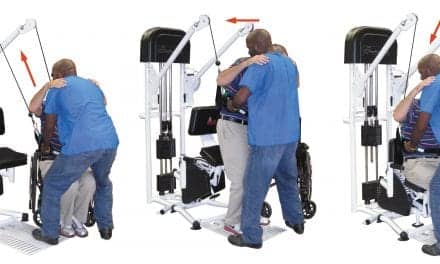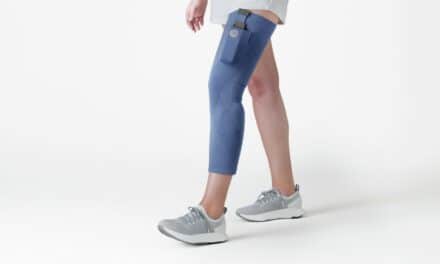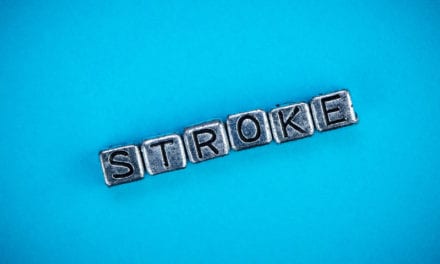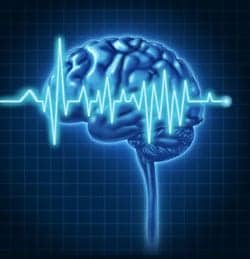
Chris Daughtry, OTR/L, ATP, demonstrates pressure qualities of a cushion to his patient. A pressure mapping system is used to train patients on proper pressure relief and how to best use the cushion to prevent skin breakdown or ulcers.
by Chris Daughtry, OTR/L, ATP Seating clinics are an integral part of a rehabilitation hospital, but can often have a waiting list or even be difficult to find. It is not uncommon for patients to travel hours to attend the nearest clinic. As a wheelchair user for more than 25 years, I understand and appreciate the need for specialty seating and mobility evaluation. I hope to shed light on the complex, yet necessary, process of obtaining mobility devices and the invaluable benefits the devices and seating clinics provide to patients.
Obtaining Mobility Devices
Obtaining specialty manual and power chairs has become more difficult due to complex insurance requirements. Therapists working in seating clinics spend as much or more time with documentation justification as with the actual evaluation of a client. Each type of chair and its various components now require specific justification. Durable Medical Equipment (DME) vendors often request additional documentation or letters of medical necessity to avoid denials or to prevent delay of delivery. Even with thorough documentation, however, it can still take months to meet a client’s mobility needs and acquire a chair. Regardless of the strength of the justification, if lesser off-the-shelf items have not been ruled out, then custom options will not be covered.
The Evaluation Process
A wheelchair is really just an orthotic. The goal of seating clinics is to fit a client’s chair so well, others see past the wheelchair and see the person’s abilities. The evaluation process begins when clients come through the door. Their mobility, posture, and function are observed throughout the evaluation. Establishing equilibrium allows for as much function as possible. Gravity, center of mass, pressure, friction, material, and temperature are some of the factors that influence a seating prescription. The goal is to prevent ulcers, contractures, and spasticity while increasing mobility and independence. The importance of function when doing a seating evaluation cannot be emphasized enough. Most wheelchair users will sacrifice seating for function. Listening and not making assumptions is critical. If a primary caregiver is involved, listening to their needs and technology threshold is also an important component. A thorough history reveals where the person uses the chair and for what purposes. The primary diagnosis, any comorbidity, and the client’s prognosis and stability are included. The seating evaluation is more accurate and efficient with a team approach. At a minimum, the client, primary caregiver, DME provider, and therapist are included. Speech therapy is also included when augmentative communication devices are used on the wheelchair. A thorough system review in which assessment of communication, cognition, vision, respiration, heart rate, and other areas, as appropriate, takes place, spending time on the integumentary system. Skin condition and risk for ulcers are a major part of this step. Pressure mapping is often used with high-risk clients to identify areas of concern, adjust posture, and prescribe pressure relief options. The pressure map displays the areas of highest pressure and ensures clients have good pressure distribution on the greatest surface area possible. Good symmetry is pursued, and heat and moisture should also be considered. When mapping, the client is viewed sitting still and while mobile over a period of time to get a good feel for their sitting tolerance. The mapping system is also a good teaching tool on how to perform pressure relief. Various types of cushions are used for pressure relief. Foam, urethane honeycomb, gel, air, and hybrid are the most common. Air cushions are the preference for clients with a high risk of ulcers. The downside to an air cushion is stability and posture, so sometimes hybrids or air cushions that are compartmentalized are used to provide more stability and trunk control. When selecting seating interfaces, consideration should be made for length, width, thickness, and material. The assessment of activities of a client’s daily living is key to establishing functional needs and also to help with the chair’s justification. Transfers are important to consider, as the height of the chair has to allow the client to be able to do so. When looking at balance and mobility, standardized tests are used, such as the Functional Reach Test, Timed Get Up and Go (TUG), and the Berg Balance Test, to objectively identify deficits and justify the need for equipment intervention. The home environment is also evaluated in the seating assessment. Changing chair width or camber could prevent a client from having access to rooms in their home. Technology has made home environment evaluations much easier, as clients can bring in pictures on their mobile devices or provide virtual tours using a tablet. The client’s vehicle is also evaluated to determine transportation needs. Strength of the patient is assessed to determine whether that person can propel a manual or lightweight chair, or if a power chair will be needed. When assessing a patient’s strength, movement patterns, postural control, gross strength, and reach are reviewed. Grip strength and hand control are important when considering push or the type of power input controls the client may need to drive the chair. Mat evaluation follows the strength assessment. The empty chair is reviewed to determine whether there are pressure areas missed in mapping. The mat exam includes a comparison of range of motion (ROM) in sitting verses supine, and a second look at joints and contractures in the supine position. The patient’s transfer is observed to gather more functional information, and the pelvis is reviewed to determine how knee flexion and extension affect the pelvic position while on the mat.
Choosing the Right Fit
Clinicians can make the false assumption that just because someone can walk, that person can also complete instrumental activities of daily living (IADLs) and activities of daily living (ADLs) independently. Simply because a client can push a manual chair does not mean that person does not need an ultralight wheelchair or power chair for optimum functional independence. Dependent bases are typically used for clients who have severe postural deformities and physical limitations. They are best for dependent weight shifts, caregiver access, and providing positioning for stability and control. Dependent bases can be rigid or folding. These chairs are not easy to transport and have a large footprint. Independent chairs can be standard height or hemi height for someone who foot propels the chair. These ultralight chairs are customized to optimize function, have a fully adjustable axle, and the center of gravity adjusts in both directions. Once a chair has been selected, wheelchair components are needed. Correct measurement is important, because something as simple as having the leg rest too short can cause the knees to be higher than the hips and increase pressure on the ischials. Wheels vary from basic mag to very lightweight fiber spoke wheels, and are available in pneumatic and solid versions. For impaired grip, projections or coating may be considered. A client who is highly active will need aluminum so the rim slides easily through the hand. When deciding on what type of wheel lock to use, a client’s ROM, reach, and strength are major considerations. For a stroke patient, push-to-lock brakes with an extension are often recommended so the client can lock both brakes with one arm. The terrain through which the client primarily maneuvers typically helps determine the wheel and caster type and size. Hip guides are used to center the pelvis in the wheelchair. Abductors are used to separate the knees. Head rests provide support during tilt or mobility. Problems with the head are often caused by poor positioning in the pelvis or back. If a patient has the need for additional postural supports, such as laterals, the overall width of the chair is affected. The majority of power chairs we prescribe are mid-wheel-drive because of the smaller footprint and improved turning radius. The technology in these chairs has improved and is less prone to tipping in outdoor terrains. One of the biggest decisions in optimizing a power chair is the input device. The simple input device is often best because it can range from a simple joystick, to high-tech head arrays or tongue controls. The more limited a client’s movement, the more it is necessary to rely on technology for independent mobility. Multiple trials and training with high-end input devices are recommended. Another option for someone with limited movement is switches. Switches can be placed anywhere on the chair and used to control all features. Sip and puff (SNP) and tongue systems are used for very impaired clients. Home environmental control units can also be incorporated into the chair’s electronics for more independence. Power seat functions include tilt, recline, elevation, and elevating leg rest. Some power chairs also have power standing options. Power standing can have vocational and medical implications.
Accessories for Convenience, Protection, and Safety
Mobility device users increasingly are accessing their communities as the Americans with Disabilities Act transforms structural design for sidewalks, building entrances, and other public facilities. Considerations, therefore, must be made for equipping mobility devices with accessories that offer protection from the elements and add convenience for activities outside the home. An important item within this category includes wheelchair-mounted canopies designed to offer protection from sunlight and rain. Among the options available for canopies are models designed for universal fit and manufactured with vented fabric on the sides. Another accessory mobility device users may find useful in helping them remain hydrated inside or outside the home are cup holders. These products can accommodate liquid beverage containers of a variety of shapes and sizes, and can be mounted to wheelchair frames to offer convenient access. Accessories such as seatback bags, trays, and holders for canes and other assistive devices offer portability for items that mobility users may need during community-based travel. Likewise, LED light systems may be added to wheelchairs as a way to increase visibility and safety during outdoor operation. Unfortunately, insurance coverage for wheelchair accessories may be very limited, but these products are widely available from manufacturers and online sources. Back supports for both power and manual chairs are used to accommodate or support the trunk. Backs can be used for positioning and pressure relief. Backs come in minimum, moderate, and deep contour, and can have air, gel, and foam components just like the seat cushion. A well-fitted wheelchair can greatly improve a person’s ability to function independently in the home and community. If a client needs a specialty wheelchair, therapists would do well to consider recommending a seating clinic with a multidisciplinary team. RM Chris Daughtry, OTR/L, ATP, is director of therapy operations at AnMed Health Rehabilitation Hospital, and has nearly 20 years of occupational therapy experience. After identifying the need in his community, Daughtry began working with vendors and obtained his Assisted Technology Professional certification from Rehabilitation Engineering and Assistive Technology Society of North America (RESNA). He leads AnMed Health’s Wheelchair Seating and Mobility Clinic and is also the regional director of therapy for the HealthSouth MidAtlantic region. As a paraplegic himself, Daughtry shares a unique insight in working with his patients and understanding their perspective. For more information, contact [email protected].






